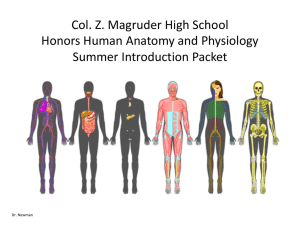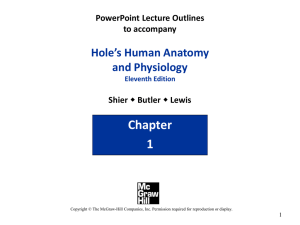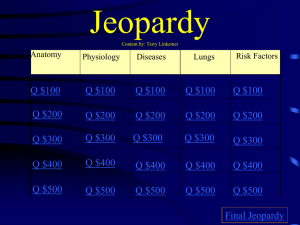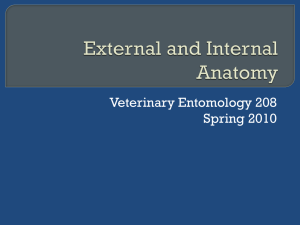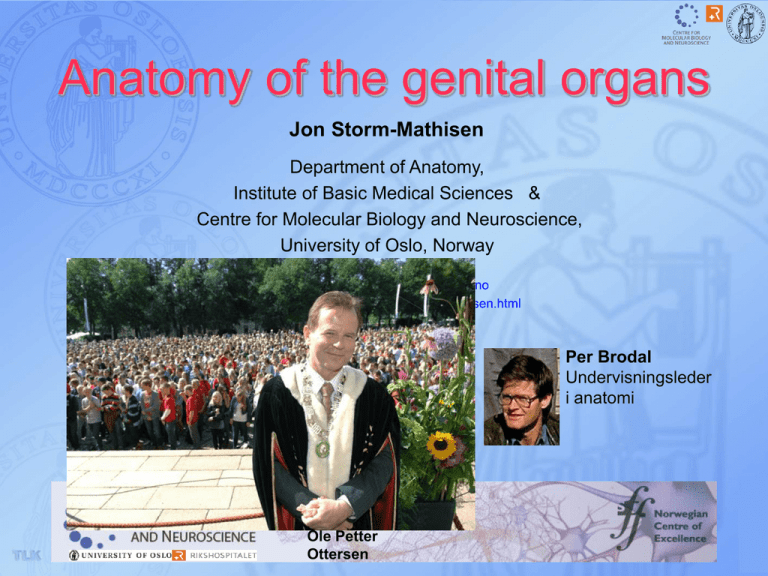
Anatomy of the genital organs
Jon Storm-Mathisen
Department of Anatomy,
Institute of Basic Medical Sciences &
Centre for Molecular Biology and Neuroscience,
University of Oslo, Norway
jon.storm-mathisen@medisin.uio.no
http://www.cmbn.no/group-storm-mathisen.html
Per Brodal
Undervisningsleder
i anatomi
Ole Petter
Ottersen
The Pelvic Region: Introduction
to its Functional Anatomy
Per Brodal
Institutt for medisinske basalfag
Universitetet i Oslo
9th Semester 2008
Anatomy 9th Semester
Lectures
•
•
gross anatomy, histology (microscopic anatomy),
embryology
Intention: overviews, help to self-study
Practicals Histology
•
assumes a certain level of theoretical knowledge
(lecture given a few days in advance of the practical
classes)
Gross Anatomy Demos
•
three PBL-groups (20-25 students)
Demos, cont’d
Keep the group-size optimal: Meet at your scheduled
time!
You are not allowed to switch to another group for
convinience
Study the booklet for the Demos in advance
(”Kompendium”, sold at the Akademika)
Assessment
Practical anatomy test (see page 41 in the Semester
Booklet)
Modified OSCE - four anatomy stations
•
•
Photomicrographs of histological sections
Theoretical questions – functional anatomy:
emphasis on clinically relevant topics
Some Advice About Learning Anatomy..
Always try to find the link between structure and
function
You must know a fair number of names to able to
communicate..
..but don’t get lost in details
The real challenge is to establish ones own
internal three-dimensional pictures
Therefore: spend ample time with prosected
specimens, models and microscopic slides
Anatomic nomenclature used in this
semester
Latin/greek – classical anatomical nomenclature
English based on latin/greek but modified
grammatically
Norwegian terms
A mess??
Tasks of the Human Pelvis
Transition between the back and the lower
extremities
Special requirements due to our upright, two-legged
walking
Container of viscera – carrying some of the weight of
the abdominal content
Birth channel
The Pelvic Girdle (bekkenet)
Iliosacral joint
Pelvis major
(store bekken)
Pelvis minor
(lille bekken)
Symphysis
Rauber/Kopsch: Anatomie des
Menschen 1987
L5
Linea
terminalis
Sacrum
Os coxae (innominate bone, hip bone)
Os ilium
Spina iliaca anterior
superior
Facies auricularis
(Iliosacral joint)
Incisura ischiadica
major (greater
ischiadic notch)
Spina ilaca posterior
superior
Os ischii
Spina ischiadica
Foramen
obturatum
Incisura ischiadica
minor
Os pubis
Lateral view
Medial view
Tuber
ischiadicum
(Ischial
tuberosity)
Ossification of Os Coxae
Os ilium
10 year
Os pubis
Os ischii
Wolf-Heidegger’s Atlas of
Anatomy, Vol 1.
GROWTH
ZONES CLOSE
AT 16-18
YEARS
Infant, 3
months
Ligaments and openings of the pelvis
Sacroiliac ligaments
Promontorium
Foramen
ischiadicum majus
Ligamentum
sacrospinale
Foramen
ischiadicum minus
Ligamentum
sacrotuberale
Thieme, Atlas of Anatomy 2006
Landmarks – The Michaelis’ Rhomboid
Iliac crest
Spina iliaca
posterior
superior
Spinous process
of L4
Michaelis’ rhomboid
Anal cleft
(rima ani)
Thieme, Atlas of Anatomy 2006
Characteristics of the female pelvis
Normal birth depends on:
a)
The expulsive forces
b) The passages
c)
The passenger
The female pelvis
is ”designed” to
give room for the
exit of the
”passenger”
Characteristics of the female pelvis, cont’d
Factors contributing to wider
passages in the female :
•
•
•
•
•
•
Larger diameters of pelvic inlet
Less protruding promontory
Wider subpubic angle
Wider distance between the
ischial tuberosities and the
ischial spines
Wider and lower symphysis
The sacrum curves less than in
the male
The Diameters of the Birth Canal
Transverse diameter = 13 cm
(Tverrvidden)
Antero-posterior diameter = 12 cm
(conjugata vera, likevidden)
Transverse diameter = 11 cm
(intertubarvidden)
Antero-posterior diameter =12,5 cm
(diameter recta, likevidden)
Bispinous diameter = 10,5
cm (Interspinalvidden)
The Bony Passages
Antero-posterior diameter = 12 cm
(conjugata vera, likevidden)
Antero-posterior diameter =12 cm
(diameter recta, likevidden)
Pelvic Fracture?
Per Brodal 2008
Hamilton Bailey’s Physical Signs in
Clinical Surgery
18
The fetal skull
Suboccipitobregmatic diameter =
9,5 cm
Llewellyn-Jones 1999
Anterior fontanelle
(Bregma)
Biparietal
diameter = 9,5
Moulding during labor
Soft Parts of the Passages
Peritoneum
Sheets of muscles and connective tissue
Several overlapping layers
Funnel-shaped
Stretched and pushed aside during
childbirth
Subcutaneous and subperitoneal spaces
with loose connective tissue, vessels,
nerves and lymph nodes
Pelvic floor muscles
(levator ani)
Muscles of the pelvic floor
Levator ani muscle
Urogenital
diaphragm with
sphincter muscles
Thieme, Atlas of Anatomy 2006
Formation of the Birth Canal and
Moulding of the Fetus During Labour
Amniotic
fluid
Soft tissues
Skeleton




